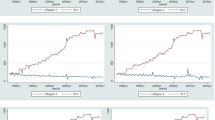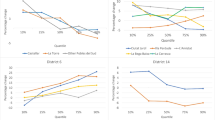Abstract
This study measures the price and income elasticity of demand for tap water, being essential for investment planning and other future business planning in Japan, where water demand is declining due to population decline. The estimation comes from panel data obtained from water utility companies between FY 2015 to FY 2020. The results show that the price elasticity of demand ranges between − 0.046 and − 0.041, while the income elasticity of demand ranges between 0.042 and 0.068. Both price and income elasticities were lower than in estimates from previous studies.
Access this chapter
Tax calculation will be finalised at checkout
Purchases are for personal use only
Similar content being viewed by others
References
Dalhuisen, J. M., Florax, R. J. G. M., de Groot, H. L. F., & Nijkamp, P. (2003). Price and income elasticities of residential water demand: A meta-analysis. Land Economics, 79(2), 292–303.
Fenrik, S. A., & Getachew, L. (2012). Estimation of the effects of price and billing frequency on household water demand using panel of Wisconsin municipalities. Applied Economics Letters, 19(14), 1373–1380.
Gaudin, S. (2006). Effect of price information on residential water demand. Applied Economics, 38(4), 383–393.
Mazzanti, M., & Montini, A. (2006). The determinants of residential water demand: Empirical evidence for a panel of Italian municipalities. Applied Economics Letters, 13(2), 107–111.
Miyawaki, K., Omori, Y., & Hibiki, A. (2011). Panel data analysis of Japanese residential water demand using a discrete/continuous choice approach. Japanese Economic Review, 62(3), 365–386.
Miyawaki, K., Omori, Y., & Hibiki, A. (2016). Exact estimation of demand functions under block-rate pricing. Econometric Review, 35(3), 311–343.
Murase, K., Nakamura, A., & Kawasaki, H. (2005). An analysis for demand structure and price of domestic water supply. Proceedings of Hydraulic Engineering, 49, 475–480. (In Japanese).
Musolesi, A., & Nosvelli, M. (2007). Dynamics of residential water consumption in a panel of Italian municipalities. Applied Economics Letters, 14(6), 441–444.
Reynaud, A., Lanzanova, D., Milovanovic, M. B., & de Roo, A. (2016). Informing water policies with a residential water demand function: The case of Serbia. European Journal of Comparative Economics, 13(2), 247–266.
Schleich, J., & Hillenbrand, T. (2009). Determinants of residential water demand in Germany. Ecological Economics, 68(6), 1756–1769.
Schleich, J., & Hillenbrand, T. (2019). Residential water demand responds asymmetrically to rising and falling prices. Applied Economics, 51(45), 4973–4981.
Shimizu, J. (1991). Estimation of household water demand function. The Quarterly Journal of Agricultural Economy, 45(2), 27–43. (In Japanese).
Urakami, T. (2000). Estimation of residential water demand function with aggregated data in Japan. Journal of Public Utility Economics, 52(2), 97–102. (In Japanese).
Acknowledgements
This research is supported by JSPS KAKENHI (Grant Numbers JP20K01613, JP21K01473).
Author information
Authors and Affiliations
Corresponding author
Editor information
Editors and Affiliations
Rights and permissions
Copyright information
© 2023 The Author(s), under exclusive license to Springer Nature Singapore Pte Ltd.
About this chapter
Cite this chapter
Nakayama, N., Urakami, T. (2023). Estimation of Tap Water Demand in Japan: A Panel Data Analysis. In: Mizutani, F., Urakami, T., Nakamura, E. (eds) Current Issues in Public Utilities and Public Policy. Kobe University Monograph Series in Social Science Research. Springer, Singapore. https://doi.org/10.1007/978-981-19-7489-2_3
Download citation
DOI: https://doi.org/10.1007/978-981-19-7489-2_3
Published:
Publisher Name: Springer, Singapore
Print ISBN: 978-981-19-7488-5
Online ISBN: 978-981-19-7489-2
eBook Packages: Economics and FinanceEconomics and Finance (R0)




